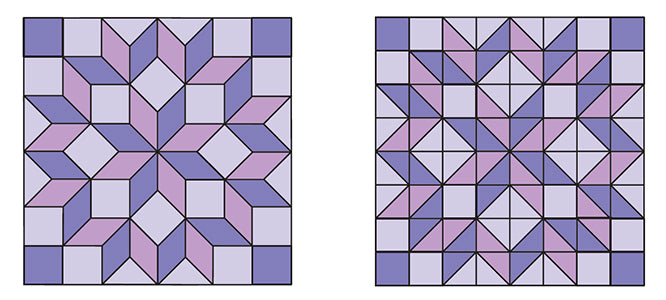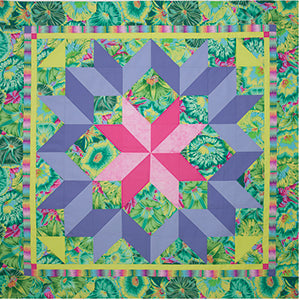Add Parallelograms to Your Cutting Skills
There have been several blocks in the Free Block Friday series where 2 half-square triangles were sewn together to make what is most frequently called the large triangle in the Flying Geese unit. The bonus when you are using the From Marti Michell templates is that you have learned a cutting trick to cut that unit to size and eliminate the sewing and pressing.

In the Rocky River block, 2 half-square triangles are joined in a different arrangement to make a parallelogram. Again, because of the engineered corners on the templates you can also cut the parallelogram and eliminate the sewing and pressing. Every seam you can eliminate saves cutting, sewing and pressing time.

A parallelogram is a quadrilateral (4-sided figure) with opposite equal length sides as well as opposite equal angle corners. In patchwork, most parallelograms have one pair of 45º opposite corners and are called diamonds.
Perhaps the most beloved, well known patchwork block that incorporates parallelograms is the Carpenter’s Wheel. We show it first in Volume 1 of the Encyclopedia of Patchwork Blocks (Product #8342) where it is made with 96 half square triangles and 16 squares with either Set A or B. We visited it again in Volume 3 of the Encyclopedia of Patchwork Blocks, Product #8345 using 45 diamonds and set-in seams. We also have a Carpenter’s Wheel pattern for use with Set A (Product #8506).
 |
 |
 |
However, if you really want to immerse yourself in the Carpenter’s Wheel block, we suggest Marti’s book 5 is Fabulous, Volume 5 in the Encyclopedia of Patchwork Blocks (#8229), where we look at parallelograms much more closely. This book celebrates the introduction of Perfect Patchwork Template Set T, based on a 5ʺ square and its most common parts. It was a perfect chance for us to use 5ʺ units to make a lovely 40ʺ Carpenter’s Wheel sampler quilt.

Here is a little tidbit excerpted from 5 is Fabulous! we hope you will enjoy.
My love affair with Carpenter’s Wheel quilts began in 1978. The 1978 Quilt Engagement Calendar compiled by Cyril I. Nelson (published by E.P. Dutton), featured a very graphic single block quilt approximately 78ʺ square and thought to be made in Pennsylvania around 1890. More recent research would suggest that the strong solid red, green and cheddar color scheme appears to be from a Mennonite home. The center block on the calendar quilt was framed with a small sawtooth green and cheddar border followed by a dark green border. I loved it so much that I made a smaller version about 45″ square, wrote instructions, and cut and sold kits through our first company, Yours Truly, Inc. The Mennonite quilt and Moonglow are at nearly opposite ends of the fabric spectrum, but the dynamic one-block pattern will link them forever.

How is a Carpenter’s Wheel Made?
You could do it with squares, triangles, real 45 diamonds and lots of “Y” seams, shown below left—it is a beautiful block!

Or you could make it with “fake 45 diamonds” and no “Y” seams, shown above right. This, too, is a beautiful block; it is just different. Do you remember the first time you saw a zirconium ring and how it sparkled almost like a real diamond? Around the same time women discovered fake gems could make beautiful jewelry, they also discovered that “fake geometric diamonds” could make beautiful quilts.
The easiest way to spot a “fake”, or what we affectionately call a “Zirconium Carpenter’s Wheel,” is to look at the squares surrounding the center star, not at the star. If the squares are the same size, the diamonds are real. If there are two sizes of squares, the diamonds are fake! They are parallelograms, whether they are one piece or 2 triangles joined together.

Moonglow, 49ʺ (124.5 cm) square Block size: 40ʺ (101.6 cm) square
Complete instructions are in 5 is Fabulous!





Leave a comment